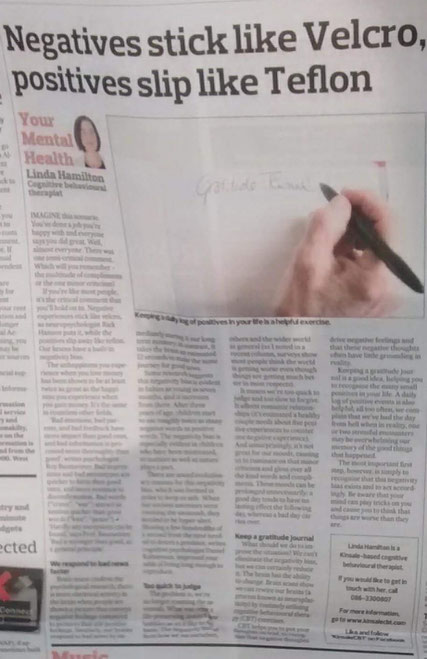
You might receive dozens of compliments and a single critical comment, but that one negative comment is the one you remember. Why so? In last week's Southern Star, I explored how we have a built-in negativity bias and why "bad is stronger than good, as a general principle". The column is below.
Imagine this scenario. You’ve done a job you’re happy with you’re with and everyone says you did great. Well, almost everyone. There was one one semi-critical comment. Which will you remember – the multitude of compliments or the one minor criticism?
If you’re like most people, it’s the critical comment that you’ll hold on to. Negative experiences stick like velcro, as neuropsychologist Rick Hanson puts it, while the positives slip away like teflon. Our brains have a built-in negativity bias. The unhappiness you experience when you lose money has been shown to be at least twice as great as the happiness you experience when you gain money. It’s the same in countless other fields. ‘Bad emotions, bad parents, and bad feedback have more impact than good ones, and bad information is processed more thoroughly than good’, writes psychologist Roy Baumeister. Bad impressions and bad stereotypes are quicker to form than good ones, and more resistant to disconfirmation. Bad words (“crime”, “war”) attract attention quicker than good words (“love”, “peace”). ‘Hardly any exceptions’ can be found, says Prof. Baumeister. ‘Bad is stronger than good, as a general principle’.
Brain scans confirm the psychological research; there is more electrical activity in the brain when people are shown a picture that conveys negative feelings compared to pictures that stir positive feelings. Similarly, our brains respond to bad news by immediately storing it our long-term memory; in contrast, it takes the brain an estimated 12 seconds to make the same journey for good news. Some research suggests this negativity bias is evident in babies as young as seven months, and it increases from there. After three years of age, children start to use roughly twice as many negative words as positive words. The negativity bias is especially evident in children who have been mistreated, so nurture as well as nature plays a part.
There are sound evolutionary reasons for this negativity bias, which was formed in order to keep us safe. When our ancient ancestors were roaming the savannah, they needed to be hyper-alert. Shaving a few hundredths of a second from the time needed to detect a predator, writes cognitive psychologist Daniel Kahneman, improved your odds of living long enough to reproduce.
The problem is, we’re no longer roaming the savannah. What was once a life-preserving instinct now hobbles us on a day-to-day basis (continued below...)
NEGATIVE EFFECTS

The negativity bias affects how we see ourselves, others and the wider world in general (as I noted in a recent column, surveys show most people think the world is getting worse even though things are getting much better in most respects). It means we’re too quick to judge and too slow to forgive. It affects romantic relationships (it's estimated a healthy couple needs about five positive experiences to counter one negative experience). And unsurprisingly, it's not great for our moods, causing us to ruminate on that minor criticism and gloss over all the kind words and compliments. These moods can be prolonged unnecessarily: a good day tends to have no lasting effect the following day, whereas a bad day carries over.
SUGGESTIONS
What should we do to improve the situation? We can’t eliminate the negativity bias, but we can certainly reduce it. The brain has the ability to change. Brain scans show we can rewire our brains (a process known as neuroplasticity) by routinely utilising cognitive behavioural therapy (CBT) exercises. CBT helps you to put your thoughts on trial, to recognise that negative thoughts drive negative feelings and that these negative thoughts often have little grounding in reality.
Keeping a gratitude journal is a good idea, helping you to recognise the many small positives in your life. A daily log of positive events is also helpful; all too often, we complain that we’ve had the day from Hell when in reality, one or two stressful encounters may be overwhelming our memory of the good things that happened.
The most important first step, however, is simply to recognise that this negativity bias exists and to act accordingly. Be aware that your mind can play tricks on you and cause you to think that things are worse than they are.